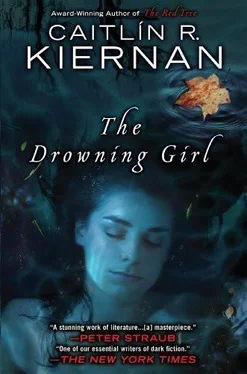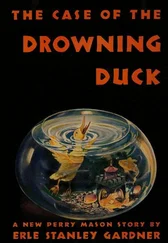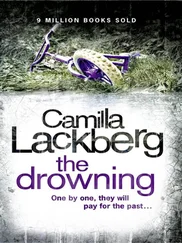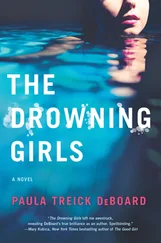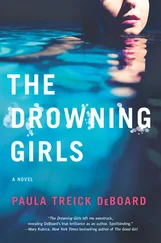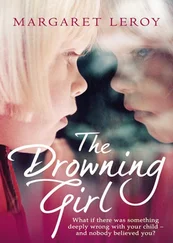Caitlín Kiernan - The Drowning Girl
Здесь есть возможность читать онлайн «Caitlín Kiernan - The Drowning Girl» весь текст электронной книги совершенно бесплатно (целиком полную версию без сокращений). В некоторых случаях можно слушать аудио, скачать через торрент в формате fb2 и присутствует краткое содержание. Год выпуска: 2012, ISBN: 2012, Издательство: Roc / New American Library, Жанр: Фэнтези, на английском языке. Описание произведения, (предисловие) а так же отзывы посетителей доступны на портале библиотеки ЛибКат.
- Название:The Drowning Girl
- Автор:
- Издательство:Roc / New American Library
- Жанр:
- Год:2012
- ISBN:978-0-451-46416-3
- Рейтинг книги:5 / 5. Голосов: 1
-
Избранное:Добавить в избранное
- Отзывы:
-
Ваша оценка:
- 100
- 1
- 2
- 3
- 4
- 5
The Drowning Girl: краткое содержание, описание и аннотация
Предлагаем к чтению аннотацию, описание, краткое содержание или предисловие (зависит от того, что написал сам автор книги «The Drowning Girl»). Если вы не нашли необходимую информацию о книге — напишите в комментариях, мы постараемся отыскать её.
The Drowning Girl — читать онлайн бесплатно полную книгу (весь текст) целиком
Ниже представлен текст книги, разбитый по страницам. Система сохранения места последней прочитанной страницы, позволяет с удобством читать онлайн бесплатно книгу «The Drowning Girl», без необходимости каждый раз заново искать на чём Вы остановились. Поставьте закладку, и сможете в любой момент перейти на страницу, на которой закончили чтение.
Интервал:
Закладка:
3
Returning, briefly, to the subject of Phillip George Saltonstall and The Drowning Girl , before returning to Eva Canning and that maybe-night in July. I’ve written that I first saw the painting on the occasion of my eleventh birthday, which is both true and factual. I was born in 1986, and am now twenty-four years old, so that year was 1997. So, that August, the painting was ninety-nine years old. Which makes it 112 at the present, and means that it was 110 the summer I first met Eva Canning. It’s odd how numbers have always comforted me, despite my being terrible at mathematics. I’ve already filled these pages with a plethora of numbers (mostly dates): 1914, 1898, #316, 1874, 1900, 1907, 1894, 1886, & etc. Perhaps there’s some secret I’ve unconsciously hidden in all these numbers, but, if so, I’ve lost or never had the codex to riddle it out.
Dr. Ogilvy suspects that my fondness of dates may be an expression of arithmomania . And, in fairness to her, I should add that during my teens and early twenties, when my insanity included a great many symptoms attributable to obsessive-compulsive disorder, I had dozens upon dozens of elaborate counting rituals. I could not get through a day without keeping careful track of all my footsteps, or the number of times I chewed and swallowed. Often, it was necessary for me to dress and undress some precise number of times (the number was usually, but not always, thirty) before leaving the house. In order to take a shower, I would have to turn the water on and off seventeen times, step in and out of the tub or shower stall seventeen times, pick up the soap and put it down again seventeen times. And so forth. I did my best to keep these rituals a secret, and I was deeply, privately ashamed of them. I can’t say why, why I was ashamed, but I was afraid, and I lived in constant dread that Aunt Elaine or someone else would discover them. For that matter, if I had been asked at the time to explain why I found them necessary, I would’ve been hard-pressed to come up with an answer. I could only have said that I was convinced that unless I did these things, something truly horrible would happen.
Always it has seemed to me that arithmomania is simply (no, not simply, but still) the normal human propensity for superstition to run amok in the mind. A phenomenon that might seem only backwards or silly when expressed at a social level becomes madness at the individual level. The Japanese fear of the number four, for example. Or the widespread belief that thirteen is unlucky, sinister, evil. Christians who find special significance in the number twelve, because there were twelve apostles. And so forth.
On my eleventh birthday, the painting was ninety-nine years old, and I wouldn’t begin any serious research into it until I was sixteen, at which point it had aged to one hundred and four (11. 99. 16. 104). I’d hardly thought about The Drowning Girl in the years since I first set eyes on it. Hardly at all. And when it reentered my life, it did so—seemingly—by nothing more than happenstance. It seemed so then. I’m not sure if it seems so any longer. The arrival of Eva may have changed coincidence to something else. I begin to imagine orchestration where before I heard only the cacophony of randomness. Crazy people do that all the time, unless you buy into the notion that we have the ability to perceive order and connotation in ways closed off to the minds of “sane” people. I don’t. Subscribe to that notion, I mean. We are not gifted. We are not magical. We are slightly or profoundly broken. Of course, that’s not what Eva said.
All my life, I have loved visiting the Athenaeum on Benefit Street. Rosemary and Caroline took me there more often than the central branch of the Providence Public Library downtown (150 Empire Street). The Athenaeum, like so much of Providence, exists out of time, preservationists having seen that it slipped through the cracks while progress steamrolled so much of the city into sleek modernity. Today, the Athenaeum isn’t so very different than in the days when Edgar Allan Poe and Sarah Helen Whitman courted among the stacks. Built in the manner of the Greek Revival, the library’s present edifice was finished in 1838 (sixty years before Saltonstall painted The Drowning Girl ), though the Athenaeum was founded in 1753. (Note the repetition of eight— at eight een or twenty-two I would have been helpless to do otherwise—1 + 7 equaling 8; 5 + 3 equaling 8; 8 + 8 equaling 16, which divided by 2 equals 8; full circle.) I couldn’t begin to imagine how many hours I’ve spent wandering between those tall shelves and narrow aisles, or lost in some volume or another in the reading room on the lowermost floor. Housed there within its protective shell of pale stone, the library seems as precious and frail as a nonagenarian. Its smell is the musty commingling fragrance of yellowing pages and dust and ancient wood. To me, the smells of comfort and safety. It smells sacred.
On a rainy day in the eighth month of 2002, on the twenty-eighth day of August, I pulled from the shelves in the Athenaeum a book published in 1958, written by an art historian named Dolores Evelyn Smithfield— A Concise History of New England Painters and Illustrators (1958 + a name with eight syllables + I was 16 = 2 × 8). Somehow, I’d never before noticed the book. I took it back to one of the long tables, and was only flipping casually through the pages when I happened across eight paragraphs about Saltonstall and a black-and-white reproduction of The Drowning Girl . I sat and stared at it for a very long time, listening to the rain against the roof and windows, to thunder far away, the footsteps overhead. I noted that the painting appeared on page 88. I used to carry loose-leaf notebooks with me everywhere I went, and an assortment of pens and pencils in a pink plastic box, and that afternoon I wrote down everything Smithfield had written about The Drowning Girl . It doesn’t amount to much. Here’s the most interesting part:
Though best remembered, when he is remembered at all, for his landscapes, one of Saltonstall’s best-known works is The Drowning Girl (1898), which may have been inspired by a certain piece of folklore encountered in northwestern Rhode Island and southern Massachusetts, along a short stretch of the Black Stone [ sic ] River. A common local yarn involves the murder of a mill owner’s daughter at the hands of a jealous fiancé, who then attempted to dispose of her body by tying stones about the corpse and sinking it in the narrow granite channel of the old Millville Lock. Some accounts have the murderer dropping the dead girl from the Triad Bridge, where the river is especially deep and wide. Tradition has it that the girl’s ghost haunts the river from Millville to Uxbridge, and possibly as far south as Woonsocket, Rhode Island. She is said to have been heard singing to herself along the banks and in the neighboring woods, and some claim she’s responsible for a number of drownings.
We can be quite certain that the artist was well enough aware of the legend, as he notes in a letter to Mary Farnum, “Perhaps I will catch sight of her myself on some evening, as I sit sketching my studies. Sadly, I’ve not yet encountered anything more exciting than a deer and a blacksnake.” While this is hardly irrefutable evidence that he named his painting for the grisly tale, it appears too much to dismiss as coincidence. Could it be that Saltonstall meant to capture a careless swimmer moments before a fateful encounter with the ghost of “the drowning girl”? It seems a reasonable enough conclusion, and one that settles the question for this author.
That same day…well, that night, I managed (much to my surprise!) to find the envelope that Rosemary Anne had made notes on all those years before, on my eleventh birthday, in the presence of the painting that had seemed like a window to me. The next day, I returned to the Athenaeum and prowled through volume after volume of Massachusetts and Rhode Island folklore, hoping to come across anything more about the story of “the drowning girl.” For hours, I found nothing at all, and was about to give up, when I finally discovered an account of the legend in A Treasury of New England Folklore by Benjamin A. Botkin (New York: Bonanza Books, 1965). Here is an excerpt, and an excerpt I found later, in another book:
Читать дальшеИнтервал:
Закладка:
Похожие книги на «The Drowning Girl»
Представляем Вашему вниманию похожие книги на «The Drowning Girl» списком для выбора. Мы отобрали схожую по названию и смыслу литературу в надежде предоставить читателям больше вариантов отыскать новые, интересные, ещё непрочитанные произведения.
Обсуждение, отзывы о книге «The Drowning Girl» и просто собственные мнения читателей. Оставьте ваши комментарии, напишите, что Вы думаете о произведении, его смысле или главных героях. Укажите что конкретно понравилось, а что нет, и почему Вы так считаете.
